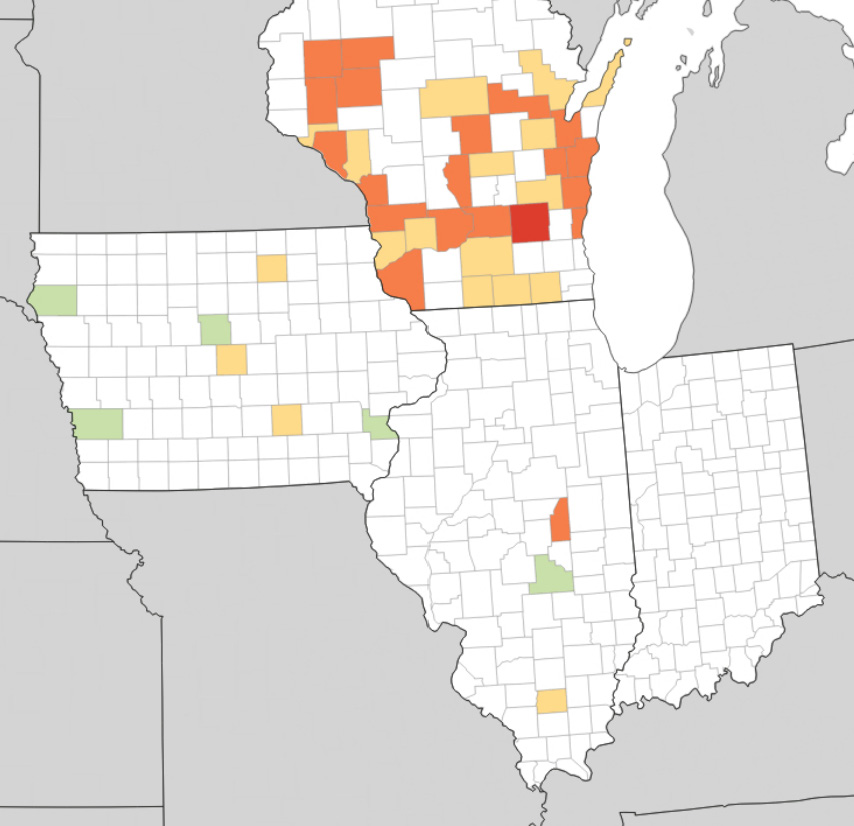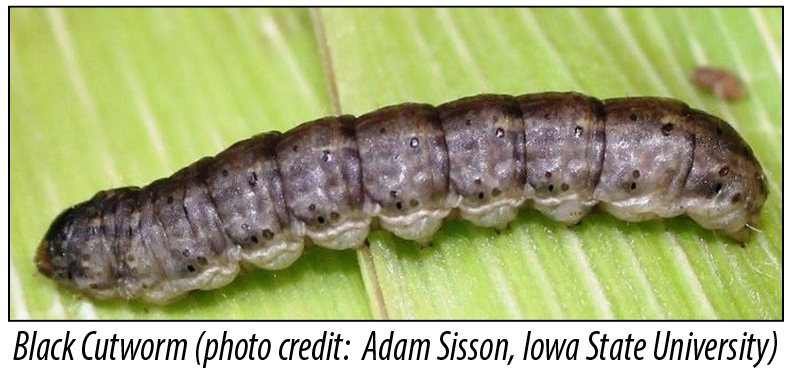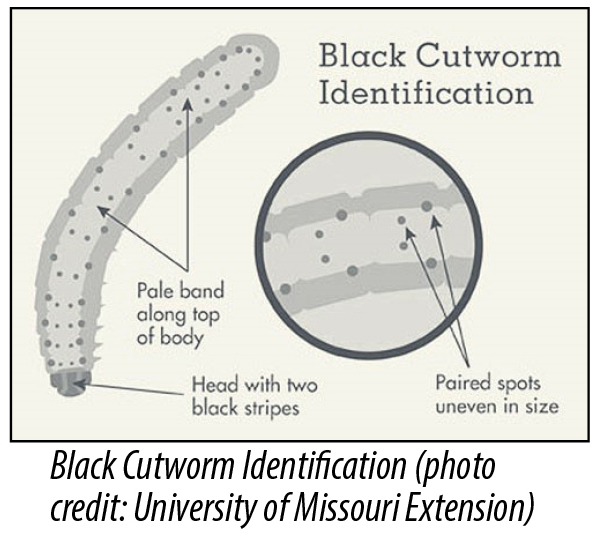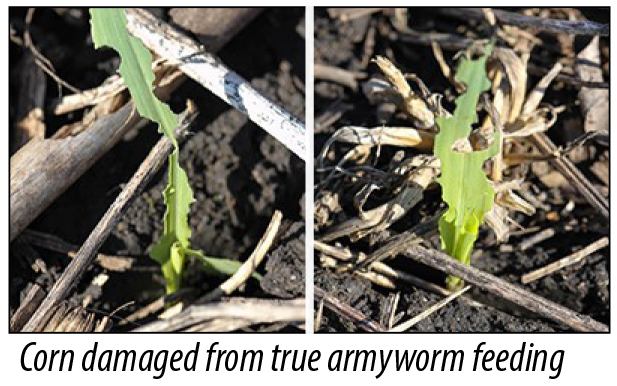Black cutworm and true armyworm are sporadic pests in the Midwest. They don’t overwinter in the Corn Belt, but the moths are carried north each spring by southerly winds. The moths themselves don’t cause economic damage, but the eggs they deposit eventually hatch into larvae which can cause significant damage by feeding on young corn plants.
Projected Cut Dates
Universities have established insect monitoring networks in their respective states to monitor moth flights and predict when damage may occur. The map below displays the counties in red that have experienced a significant moth capture. Large moth captures don’t necessarily mean damage is imminent, but should alert growers to begin scouting three to four weeks after the capture. You can go to the Corn ipmPIPE website, which is a collaboration of land-grant universities, and see an updated interactive map. If you click on each county, you will get an estimated cut date that you should target to begin scouting.

Source: Corn ipmPIPE. As of May 29, 2025
Black Cutworm
There are several species of cutworm that feed on corn in the Midwest, but the black cutworm is most common. Depending on the size of corn plants, one black cutworm larva can cut up to five corn plants in its lifetime. Black cutworm moths move up from the south with springtime winds and storms. The time and area in which cutworms will be most prevalent varies from year to year, but they typically arrive in the Midwest late March through June.
The moths are most attracted to, and will lay their eggs, in early spring vegetation. This makes fields with cover crops and no-till fields with heavy weed growth most susceptible. These fields are the highest risk and should be the first focus of scouting.
Black cutworms require about 90 growing degree days (GDD) to accumulate for egg hatch. Newly hatched larvae feed on weeds and/or young corn plants leaving small irregular holes in leaves. This early feeding does little to affect yield of young plants, but it’s an indicator of the potential for severe damage in the future. Black cutworm larvae require around 300 GDD after moth flight to reach a size large enough to cut plants.
Larger larvae may notch the stems of corn plants below the soil surface causing them to wilt and die, or they can completely cut through stalks causing major stand reductions. Black cutworms will do most of their damage at night, and then bury themselves in the soil during the day. So, if evidence of damage is found, further inspection around those plants should be done to determine if larvae are present.

Black cutworm larvae are gray to nearly black and have a greasy appearance. Black cutworm can be distinguished from other cutworm species by the unequal sized, dark spots (tubercles) on the upper edges of each body segment. The front tubercle is noticeably smaller than the rear (see photo). The larvae have three pairs of true legs and four sets of fleshy, abdominal prolegs.

Hybrids with the SmartStax® or Trecepta® traits are labeled for black cutworm protection. Control can also be achieved with pre-plant or T-band applications of insecticides. A large population can still overwhelm traits, and insecticide effectiveness depends on weather conditions, so it’s still important to scout all fields for potential damage.
A rescue treatment may be necessary if 3-5% of the plants show damage and 2 or more live larvae (less than ¾ inch in length) are found per 100 plants. Not all damaged plants will be killed. Some small plants that are cut off could re-grow if the growing point is still viable. Fields with small corn plants and large larvae are the most likely to have economic damage.
True Armyworm
True armyworms also migrate from the south in the spring. They prefer to lay eggs in grassy areas such as pastures, grass cover crops, waterways, roadsides, and along fence rows. The larvae may move out of these areas in search of available food sources like corn or small grain. Feeding in corn fields (usually along leaf margins) is evident during late May or early June.
True Armyworm larvae have 4 sets of prolegs located in the back part of the body. The base of the prolegs typically have a dark spot. The larvae will have orange stripes with white borders down each side of the body. The head is typically yellow to orange with a webbing of dark lines.

For corn seedlings (VE to V2), it is recommended that treatment occur if 10% or more of the seedlings corn plants are damaged and larvae are less than ¾ inch. For corn that is in the V7 to V8 stage, treatment should occur when larvae are less than ¾ of an inch and 25 percent of the leaf area has been damaged. Larvae that are less than ¾ inch in length will feed for another week or so and may cause additional injury. Seed applied insecticides and Bt traits won’t provide adequate protection against true armyworm, so if damage is evident and larvae are still present a rescue treatment should be applied to protect yield potential.
Don’t confuse true armyworm with fall armyworm, they are two different insects. True armyworm is a pest of late spring and summer, while fall armyworm is typically present late summer or fall. Nearly all Bt corn hybrids either control or suppress fall armyworm, but not true armyworm. Traits that contain the Viptera® gene, like Trecepta®, do exhibit control of true armyworm.

Scout to Protect Yield Potential
Black cutworm and true armyworm presence is sporadic and often field specific. The best way to know what is going on in your fields is to scout for damage. Fields with plant growth during the spring, either from winter annual weeds or cover crops, are more likely to attract egg-laying moths. If damage is detected early, a rescue treatment can be used to limit the extent of the damage and protect yield potential.
SmartStax and Trecepta are registered trademarks of Bayer Group.
Viptera is a registered trademark of Syngenta Group.
